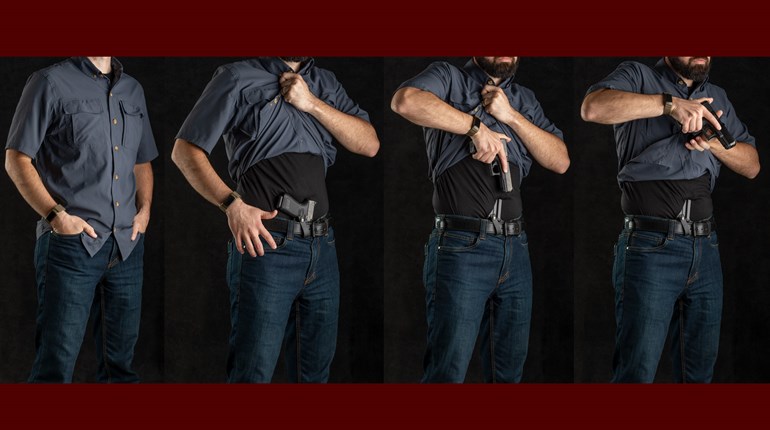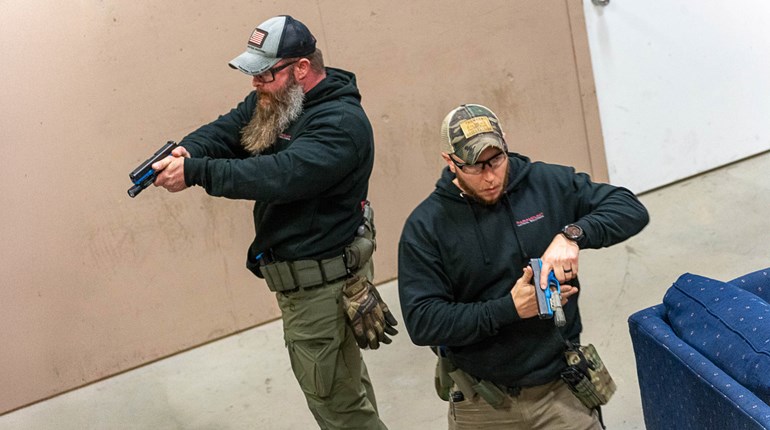
This feature appears in the April ‘17 issue of NRA America’s 1st Freedom, one of the official journals of the National Rifle Association.
In the summer of 2013, Gov. Pat Quinn of Illinois took to the stump to warn of the deadly perils associated with concealed carry. He had, he said, “campaigned in the primary and the general election against allowing private citizens to carry loaded, concealed handguns in public places”—an idea he cast as “unhealthy.” What if, he asked the assembled press corps, you’re in the supermarket and you “bump into somebody accidentally?” The person you bumped might “pull out a loaded, concealed handgun to assuage their anger!”
In any year, this question would have been asinine; the United States, as far as I’m aware, has never had much of a problem with spontaneous shopping-cart rage. But in 2013, the idea was downright risible. Far from being at the bleeding edge of reform, Illinois was on the verge of becoming the 50th state out of 50 to recognize and allow for carry rights. Had he looked even cursorily at the 49 others, Quinn would have noticed that a clear and invariable pattern had marked out the process he opposed: First had come the warnings of chaos and carnage; then had come the change, amid a sea of hysterical cries; and finally ... nothing. No crime spike. No massacres. No return to the “Wild West.” In Quinn’s fevered imagination, Americans who carry were on the cusp of snapping at any given moment. In reality, they have served as the most law-abiding people in the country. Upon what, one wonders, did his most dramatic auguries rest? When Texas moved to change its law back in the early 1990s, the then-president of the Dallas Police Association, Glenn White, lobbied hard against reform. A few years later, he conceded honorably that “the horror stories I thought would come to pass didn’t happen.”
Not upon the evidence, certainly. And nor, one can safely assume, upon a careful review of the history, for to inspect the legal shifts that we have witnessed over the last three decades is to encounter not an exercise in absolutism and folly, but a quiet, peaceful and salutary revolution in liberty. Rare is the example of freedom regained, but in the case of the right to bear arms, the American people have done it. Little by little, the right seemed to be slipping away, and then, all of a sudden, it didn’t. It is incomplete, but we are getting there.
The reversal began during the Reagan administration. In 1986, there were just eight states that generally issued concealed-carry permits to any law-abiding citizen who applied. By 1992, that number had doubled to 16; by 1997, it had nearly doubled again; and, in 2006, it reached 38. In concert, the number of states that refused to issue permits to anybody declined from 16 in 1986, to seven in 1997, and then to zero in 2013. As of today, there are just eight states left that host “may-issue” permitting regimes—states, that is, that require applicants to demonstrate “need.” And the trend is continuing in the right direction, with legislatures increasingly choosing to do away with their permitting requirements entirely. At the time of writing, there were 11 “permitless”—or “constitutional” carry—states. By the end of 2017, that number is likely to climb even higher. What was the number of constitutional carry states in 1986? One—Vermont.
Lest the scale of this change be obfuscated by the numbers, let me reiterate: Thirty years ago, Americans could exercise their right to carry in only eight of the 50 states; today, they can do so in all but eight (these eight do issue carry permits, which many didn’t in 1986, but they still treat the right as a privilege and often impose absurd conditions upon petitioners). Over the same period of time, the number of states that eschew permitting entirely has risen by a factor of 11.
And what of those “shootouts in the streets” that we were promised? Has America become the o.k. Corral?
Hardly. In fact, over the last three decades the crime rate has plummeted. In 1990, the FBI reports, there were 732 violent crimes for every 100,000 inhabitants of the United States. Property crime, meanwhile, was at 5,088; murder at 9; rape was 41; robbery at 257; assault at 418; burglary at 1,236; and motor vehicle theft at 658. Despite a minor uptick in crime in some areas during the last two years, the United States is dramatically more peaceful today than it was 25 years ago. In 2014, there were 365 violent crimes per 100,000 inhabitants—almost exactly half the rate in 1990. Also cut by half or more were property crime, murder, robbery and burglary. Motor vehicle theft had dropped by two-thirds; assault by 46 percent; and rape by 10 percent (this last statistic is an outlier in 2014; the trend is closer to the rest for the other years for which the FBI has reports). And, crucially, the same pattern is evident in the homicide-by-firearm numbers, which were sliced in half between 1991 and 2014 (from 7 per 100,000 to 3.4 per 100,000).
As for carriers themselves? It turns out that they are remarkably law-abiding—just as the architects of the restoration in carry rights said they would be. Indeed, according to data provided by the states of Florida and Texas, concealed carriers are between six and 10 times less likely to commit a crime than are police officers (who, in turn, are more law-abiding than the general population).
Occasionally, the purveyors of doom-laden prognostication will admit that they were initially mistaken. When Texas moved to change its laws back in the early 1990s, the then-president of the Dallas Police Association, Glenn White, lobbied hard against reform. A few years later, he conceded honorably that “the horror stories I thought would come to pass didn’t happen. No bogeyman.” “I think,” he added, that “it’s worked out well, and that says good things about the citizens who have permits. I’m a convert.”
Similar mea culpas have been issued by Ron Silver, a Florida state representative who famously opposed his state’s 1987 “shall-issue” bill but later admitted it had turned out fine; by Jackson County prosecutor Hank Zavislak, who campaigned against Michigan’s Right-to-Carry law but admitted to being “pleasantly surprised” by the results; and by South Carolina state Rep. Gilda Cobb-Hunter, who conceded in 2001 that there had been “no evidence of abuse” of the state’s 1996 reform, and thus dropped her “opposition to the law remaining in place.” But these acknowledgments have rarely made it into the mainstream, where the original debate seems to have been preserved in aspic. In 1987, when the trend toward carry was picking up steam, the reflexive rejoinder of the naysayers was “carnage.” Thirty years later, despite all of the evidence that has accrued, the same responses obtain. It’s Pavlovian.
Happily, the paucity of reasonable debate has done little to stop the march of change. Indeed, it seems clear now that, on the question of firearms at least, most Americans care neither for hyperbole nor for tribalism. Take a look at the relevant history and you will discover that the spread of concealed carry by no means breaks down along the usual lines. As one might expect, both Alaska and Arizona have abolished their permitting systems. But so, for that matter, has Maine. Florida, predictably, was one of the first “shall-issue” states. But it was beaten to that punch by both Washington and Connecticut. And New Mexico stayed “may-issue” until 2003, 14 years after Oregon made its switch. By the end of this year, Vermont, New Hampshire, and Maine will all be “constitutional carry” states, while Alabama, Georgia, and the Carolinas will have moved no closer to joining them. This isn’t a red-state/blue-state thing, it’s an American thing. The changes have come in a jumble.Looking back through recent history, it is difficult to find a policy reversal that has been so dramatic in scope and so salutary in nature.
And on that jumble has rolled, piece by piece, bill by bill, hearing by hearing, spreading freedom and choice in its wake. The states, Supreme Court Justice Louis Brandeis, who served on the court from 1916 to 1939, observed, are “laboratories of experimentation.” And what an experiment this has been! Looking back through recent history, it is difficult to find a policy reversal that has been so dramatic in scope and so salutary in nature. So often, irrationality prevails. So often, the talking points conquer all. “The natural progress of things,” wrote Thomas Jefferson, “is for liberty to yield, and government to gain ground.” Not here, though. The restoration of carry has been the exception to a ghastly rule.
To understand this is crucial—not only because it demonstrates how much can be achieved when the good guys choose to show up, but because, as always, knowledge must serve as a prophylactic against complacency. On the face of it, it is reassuring to hear the same absurd claims as are made by Quinn. “Is that all they’ve got?” you could be forgiven for wondering. “Have they truly learned nothing?” But dig deeper and a challenge will reveal itself: That they’re sticking with their story shows how little they care for the truth.
Or, put another way, that the opponents of carry are still here suggests that they are unlikely to go away. And, that being so, those of us who are thrilled with the progress we have made ought to redouble our efforts in the public square. As the Pew Research Center has reported, only 12 percent of Americans know that the rate of “gun crime is markedly lower than it was two decades ago”; while a majority believes it is higher. It does not take a genius to see how that might matter. In truth, the spread of concealed carry has coincided with a massive drop in crime. In the mind of the public, however ...
Which is to say that champions of the Second Amendment should do in this case what they should do in every case. First, they should congratulate themselves for their work, and then we should remember how precarious our freedoms are, and will always be. We’ve made extraordinary gains over the last 30 years, and bucked a historical trend in the process. Let’s ensure that we protect what we have done.
Charles C.W. Cooke is the editor of National Review Online.


































